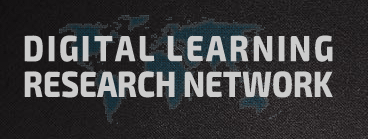 While this is my first post about my experiences with the Digital Learning Research Network: Making Sense of Higher Education 2015 – #dLRN15 – it was as a result of a couple friends and colleagues in the conference who suggested I write about this. While I liveTweeted my experiences along the way, I feel I already processed many of my thoughts while I was having them. What I did not do, however, was to bring this all to closure and attempt to summarize my take-away(s).
While this is my first post about my experiences with the Digital Learning Research Network: Making Sense of Higher Education 2015 – #dLRN15 – it was as a result of a couple friends and colleagues in the conference who suggested I write about this. While I liveTweeted my experiences along the way, I feel I already processed many of my thoughts while I was having them. What I did not do, however, was to bring this all to closure and attempt to summarize my take-away(s).
I have two take-aways from the #dLRN15 Conference:
Firstly, I feel that presenting at a conference gives me a purpose for being there. I know, learning or networking or engaging are all valuable, but those are not things that will definitely happen. They tend to happen, though I have been at a conference or two in my life when something precludes that interaction, and while I still present, very little else happens. Presenting means I need to do work before I get there, often in relationship with other people, with the intention of trying to say something new and potentially useful for others who are also in attendance. Presenting well for me often means the learning and networking and engaging follow, so as a result I find that almost forces me to interact and share ideas. While that seems self-evident, I do have a slightly introverted approach when in groups, so presenting helps me to manage that tendency.
I presented several times during the #dLRN15 conference, firstly with Rebecca Hogue in
Next, I had the honor of being invited to participate with Lee Skallerup Bessette and Petra Dierkes-Thrun, while being led by our convener and facilitator Kate Bowles in the Plenary Panel on Innovation and Work
Then, on the second day of the conference I presented two more times. The first was again with Rebecca Hogue based on work done with a number of colleagues including Maha Bali, Keith Hamon, Apostolos Koutropoulos, Ron Leunissen, and Lenandlar Singh in Pioneering alternate forms of collaboration: Technologies that support and sideline #rhizomatic learning
The second time was with Whitney Kilgore, Maha Bali, and Joyce Seitzinger in Community Hubs or Learning Opportunities: #Hashtags as Open Learning Signposts
The second take-away is that engaging with people I have known for years online is often somewhat different in person. Again, this may not be a revelation in itself, though let me explain a bit. I have known some of the people at this conference for years. Folks such as Dave Cormier, Laura Gogia, Kate Bowles, Whitney Kilgore, George Veletsianos, Lee Skallerup Bessette, and Autumm Caines (among others) all found me saying how wonderful it was to meet. I found myself saying things such as “You are taller than you look online” or “You are nicer than you sound online” or even “You don’t seem at all as you do online.” This may not be surprising, though without the connections I had with all of them on Twitter, I may not have ever sought them out to meet or speak with them at all. In fact, many of hte members of my Personal Learning Network started out from online connections, where it is at times easier to focus on ideas first without potential distractions of appearances, accents, and mannerisms. While our online identities are only parts of our complex relationships, I posit that in-person communication and connections may not be the entirety of ourselves, either. How often have we gathered together to work on something only to be distracted by context, another topic of interest, or some distractor (positive or negative) that somehow is not present when we engage over social media? There are not single, best ways to meet or engage or interact, but different ways with different realities.
BTW, meeting these folks for the first time in person was richer as a result of (in some cases) years of engagement online first. To this point, I will not pretend there can be a clear sense of closure for this conference, as it was but a moment in time where networks shift, ideas develop, and relationships strengthen, all in a richer context as a result. Where do we go from here? With new ideas and colleagues from #dLRN15, isn’t that what engaging with one’s Personal Learning Network is all about?
I sorted and articulated my Final Musings of #dLRN15 https://t.co/xnlfTbGzHt
I linked to our #dLRN15 slides https://t.co/xnlfTbGzHt @rjhogue @KateMfD @Bali_Maha @readywriting @whitneykilgore @catspyjamasnz @petradt
RT @JeffreyKeefer: I linked to our #dLRN15 slides https://t.co/xnlfTbGzHt @rjhogue @KateMfD @Bali_Maha @readywriting @whitneykilgore @catsp…
RT @JeffreyKeefer: I linked to our #dLRN15 slides https://t.co/xnlfTbGzHt @rjhogue @KateMfD @Bali_Maha @readywriting @whitneykilgore @catsp…
RT @JeffreyKeefer: I linked to our #dLRN15 slides https://t.co/xnlfTbGzHt @rjhogue @KateMfD @Bali_Maha @readywriting @whitneykilgore @catsp…
RT @JeffreyKeefer: I linked to our #dLRN15 slides https://t.co/xnlfTbGzHt @rjhogue @KateMfD @Bali_Maha @readywriting @whitneykilgore @catsp…
RT @JeffreyKeefer: I linked to our #dLRN15 slides https://t.co/xnlfTbGzHt @rjhogue @KateMfD @Bali_Maha @readywriting @whitneykilgore @catsp…
RT @JeffreyKeefer: I linked to our #dLRN15 slides https://t.co/xnlfTbGzHt @rjhogue @KateMfD @Bali_Maha @readywriting @whitneykilgore @catsp…
RT @JeffreyKeefer: I sorted and articulated my Final Musings of #dLRN15 https://t.co/xnlfTbGzHt
RT @JeffreyKeefer: I linked to our #dLRN15 slides https://t.co/xnlfTbGzHt @rjhogue @KateMfD @Bali_Maha @readywriting @whitneykilgore @catsp…
RT @JeffreyKeefer: I sorted and articulated my Final Musings of #dLRN15 https://t.co/xnlfTbGzHt
Final Musings of #dLRN15 https://t.co/ggyHUbwZwI Thanks for sharing your thoughts & resources @JeffreyKeefer